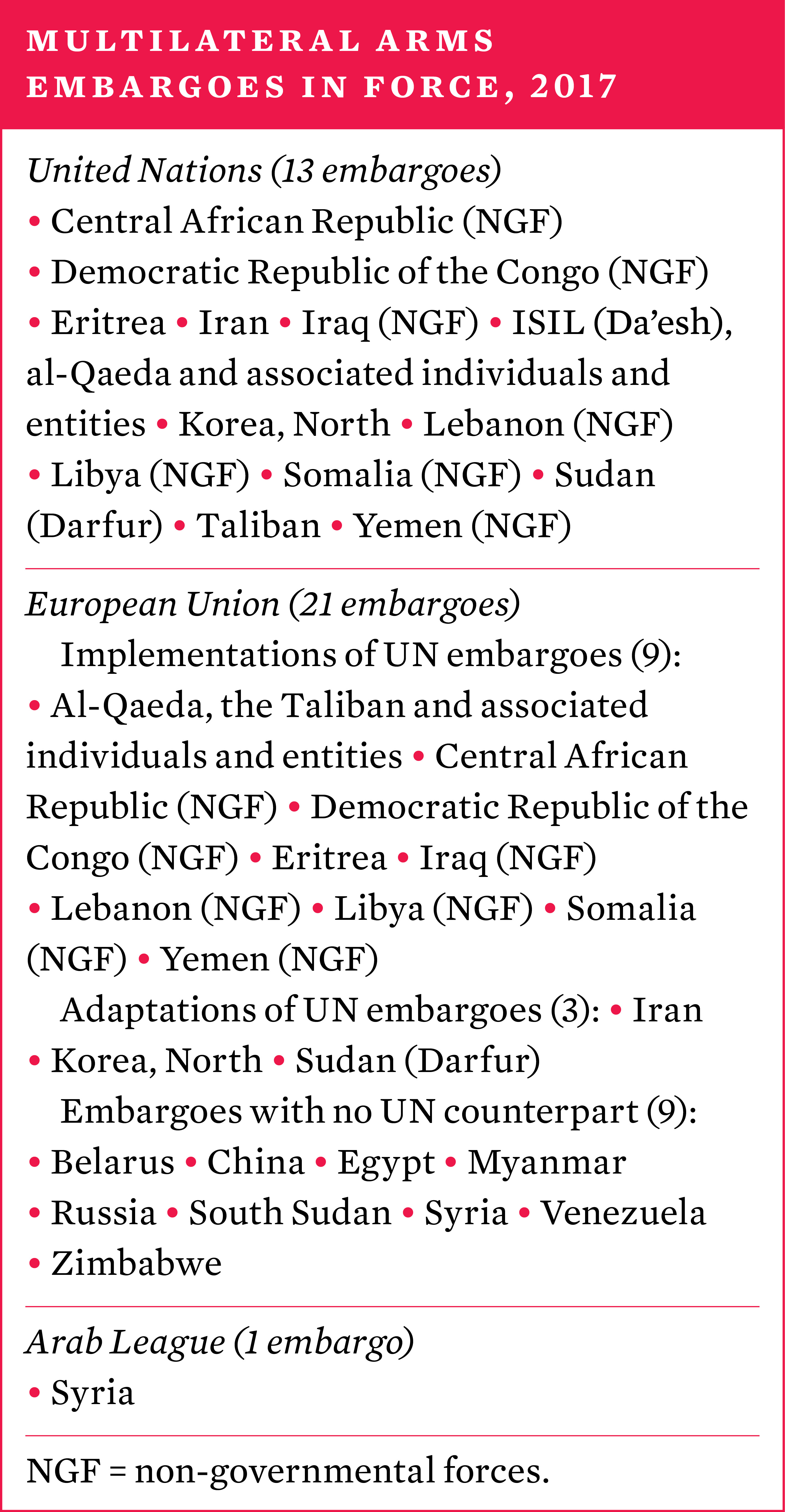10. Dual-use and arms trade control
Overview, Mark Bromley [PDF]
I. The Arms Trade Treaty, Mark Bromley and Kolja Brockmann [PDF]
II. Multilateral embargoes on arms and dual-use items, Mark Bromley and Pieter D. Wezeman [PDF]
III. The export control regimes, Sibylle Bauer, Kolja Brockmann, Mark Bromley and Giovanna Maletta [PDF]
IV. Controls on intangible transfers of technology and additive manufacturing, Mark Bromley, Kolja Brockmann and Giovanna Maletta [PDF]
Global, multilateral and regional efforts continued in 2017 to strengthen controls on the trade in conventional arms and in dual-use items connected with conventional, biological, chemical and nuclear weapons and their delivery systems. Membership of the different international and multilateral instruments that are aimed at establishing and promoting agreed standards for dual-use and arms trade controls expanded further. As in previous years, ensuring effective implementation of these instruments remained a challenge. This could be seen in disagreements between non-governmental organizations (NGOs) and states about how to measure and ensure effective implementation of the 2013 Arms Trade Treaty (ATT), the many reported violations of United Nations arms embargoes, and the difficulties associated with ensuring that dual-use and arms trade controls keep pace with advances in technology and evolving trade patterns.
The Arms Trade Treaty
The third conference of ATT states parties took place in Geneva, Switzerland, in September 2017. While the conference took a number of key decisions, the tensions between states parties and the community of NGOs that supported the creation of the ATT were again on display. Moreover, even though the number of states parties to the treaty continued to increase, the levels of compliance with reporting and funding obligations continued to fall short in several areas. Efforts to increase the number of states parties have focused on Asia in recent years and the region faces a number of the security challenges that the ATT is intended to address. However, the region’s current political dynamics also place significant obstacles in the way of further increases in the number of states parties.
Multilateral arms embargoes
Thirty-five multilateral arms embargoes were in force in 2017: 13 imposed by the UN, 21 by the European Union (EU) and 1 by the League of Arab States. Of the EU’s 21 embargoes, 9 implemented UN arms embargoes directly, 3 were similar to UN embargoes but differed in geographical scope or the types of weapon covered, and 9 had no UN counterpart. Most of these embargoes only covered conventional arms. However, the UN and EU embargoes on Iran and North Korea, and the EU embargo on Russia, also covered exports of dual-use items. One new multilateral arms embargo was imposed in 2017: an EU embargo on Venezuela. As in previous years, investigations by the UN revealed problems in the implementation of its embargoes, with numerous reported cases of violations. However, the scope and significance of these violations varied considerably, with some involving large shipments of arms in contravention of the embargo and others involving a failure by a supplier or recipient state to notify a sanctions committee about a transfer.

Export control regimes
Each of the four multilateral export control regimes—the Australia Group (AG), the Missile Technology Control Regime (MTCR), the Nuclear Suppliers Group (NSG) and the Wassenaar Arrangement on Export Controls for Conventional Arms and Dual-use Goods and Technologies (Wassenaar Arrangement, WA)—updated its respective trade control lists in 2017. As in previous years, a key challenge that all the regimes faced was ensuring that the control lists continue to account for and cover the often rapid advances in goods, software and technology. In recent years all of the regimes have faced difficulties with admitting new members, owing to the requirement that all existing members must approve an application. However, in 2017 India was admitted to the WA and in early 2018 it was admitted to the AG. This follows its admission to the MTCR in 2016. India’s application to join the NSG continues to be strongly opposed by a group of countries led by China. There were few changes in EU export controls during 2017, with the main developments involving ongoing discussions about the proposed recast of the EU Dual-use Regulation
Controls on intangible transfers of technology
The main export control regimes, EU controls on the trade in arms and dual-use items, and UN and EU arms embargoes all include requirements to exert controls on intangible transfers of technology (ITT). ITT are generally divided into those that involve transfers of technical data and those that involve transfers of knowledge and technical assistance. ITT are seen as being particularly difficult to detect, making enforcement hard for national authorities. In addition, controls on ITT can generate significant compliance costs for companies and research institutes. The problems in this area are only going to become more acute in the years to come, as new trading patterns and technologies increase the volume and range of ITT that are potentially subject to export controls. During 2017 there were discussions about how controls on ITT should be best structured and applied, particularly within the context of the review of the EU Dual-use Regulation but also in the export control regimes. Key challenges in this area include if and how export controls should apply to cloud computing and the challenges presented by additive manufacturing (also known as 3D printing) as both an enabler of ITT and a multiplier of associated proliferation risks.